Impact of Emerging Technologies on Society and the MENA Region
VerifiedAdded on 2022/12/23
|9
|2916
|49
Report
AI Summary
This report provides a comprehensive analysis of the impact of emerging technologies, particularly Artificial Intelligence (AI), on society, with a specific focus on the Middle East and North Africa (MENA) region, using Qatar as a case study. The report explores the applications of AI, including data mining and predictive analytics, across various sectors such as business, education, and healthcare. It examines the global implications of these technologies, emphasizing their role in data management, decision-making, and resource allocation. The study further delves into the cultural context of the MENA region and how it influences technology adoption, highlighting the challenges and opportunities presented by AI in areas like education, healthcare, and workforce development. The report underscores the importance of AI in addressing societal needs, predicting future trends, and improving the quality of life in the region. It also discusses the ethical considerations and potential benefits of AI implementation in the MENA region.
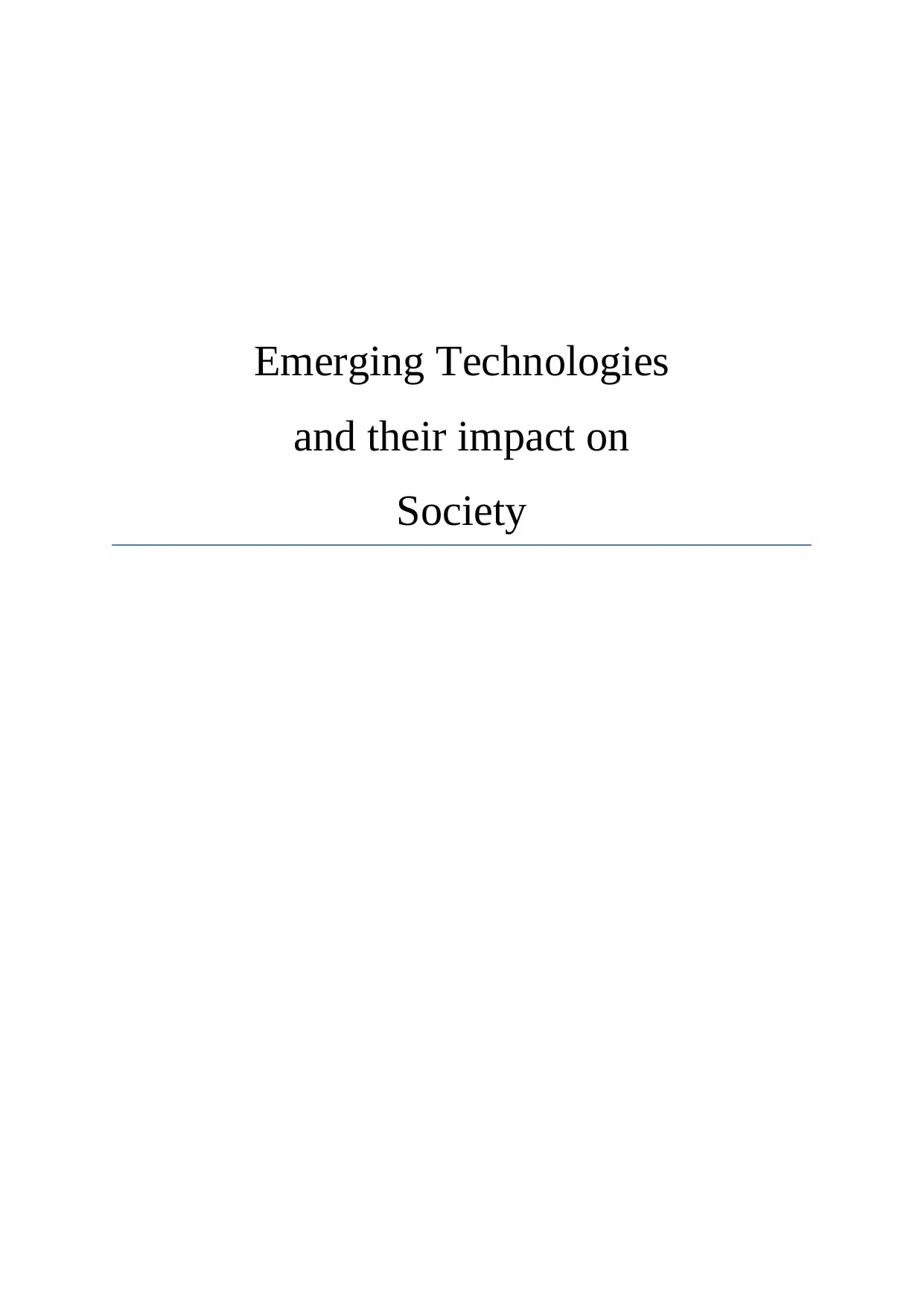
Emerging Technologies
and their impact on
Society
and their impact on
Society
Paraphrase This Document
Need a fresh take? Get an instant paraphrase of this document with our AI Paraphraser
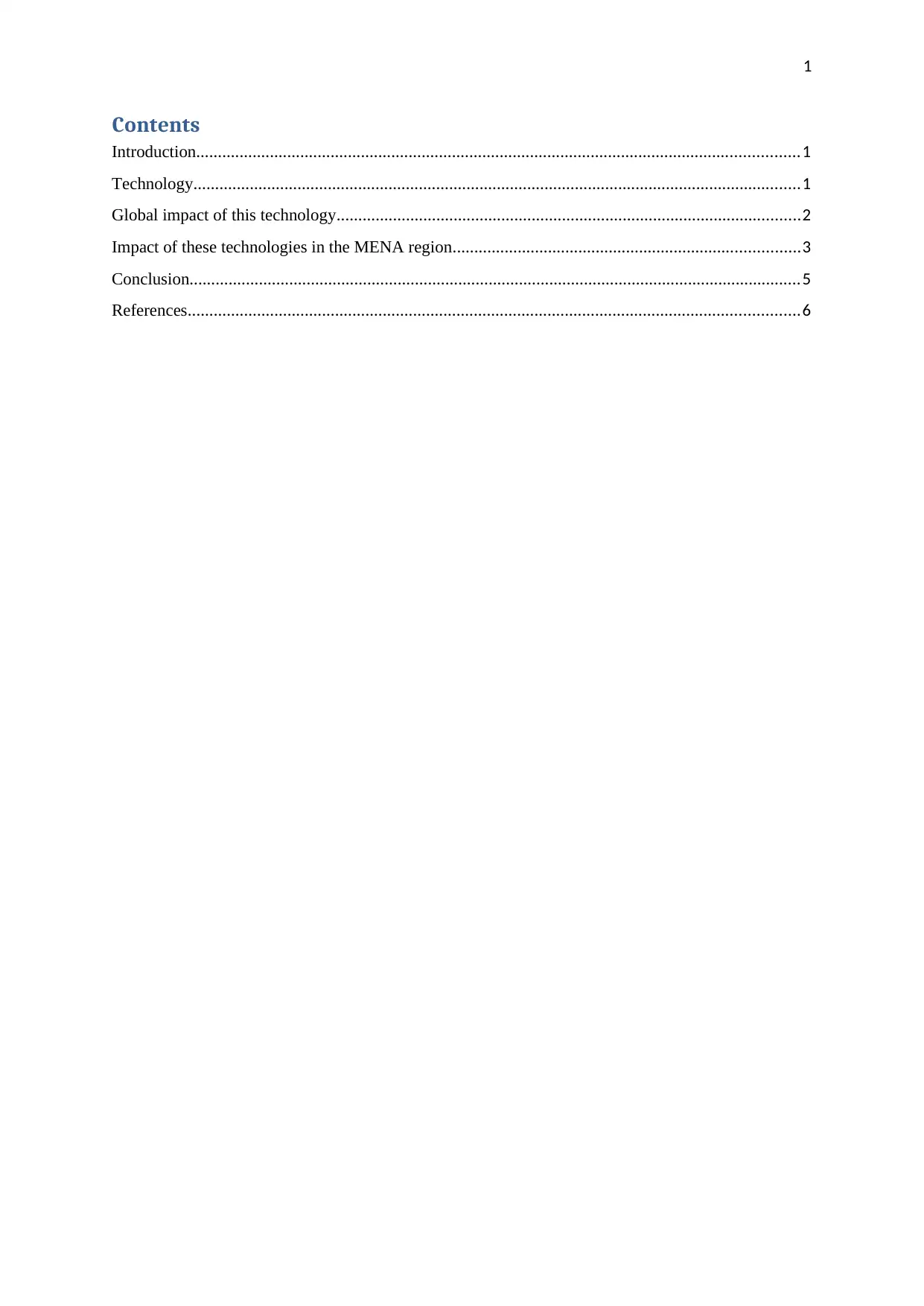
1
Contents
Introduction...........................................................................................................................................1
Technology............................................................................................................................................1
Global impact of this technology...........................................................................................................2
Impact of these technologies in the MENA region................................................................................3
Conclusion.............................................................................................................................................5
References.............................................................................................................................................6
Contents
Introduction...........................................................................................................................................1
Technology............................................................................................................................................1
Global impact of this technology...........................................................................................................2
Impact of these technologies in the MENA region................................................................................3
Conclusion.............................................................................................................................................5
References.............................................................................................................................................6
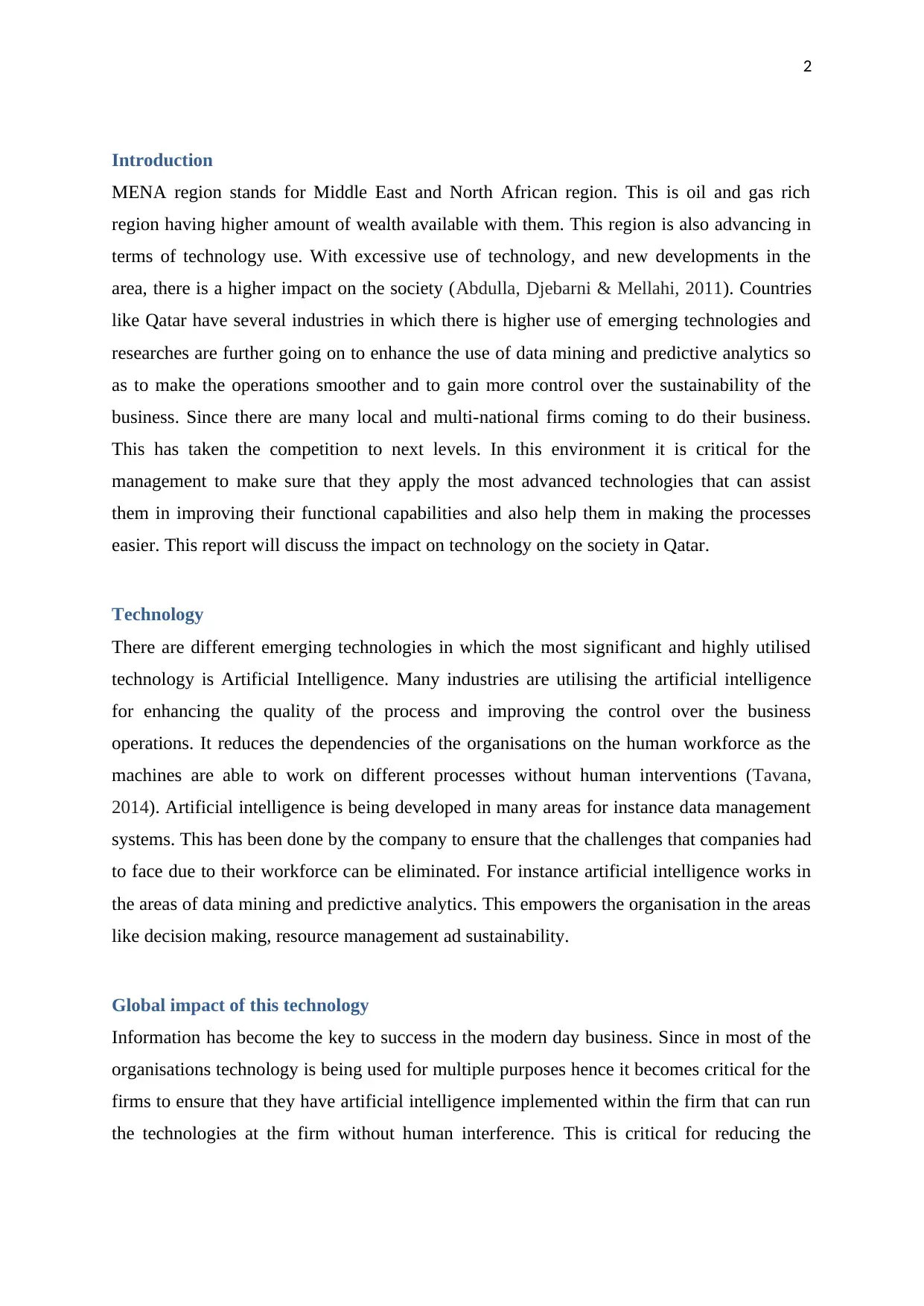
2
Introduction
MENA region stands for Middle East and North African region. This is oil and gas rich
region having higher amount of wealth available with them. This region is also advancing in
terms of technology use. With excessive use of technology, and new developments in the
area, there is a higher impact on the society (Abdulla, Djebarni & Mellahi, 2011). Countries
like Qatar have several industries in which there is higher use of emerging technologies and
researches are further going on to enhance the use of data mining and predictive analytics so
as to make the operations smoother and to gain more control over the sustainability of the
business. Since there are many local and multi-national firms coming to do their business.
This has taken the competition to next levels. In this environment it is critical for the
management to make sure that they apply the most advanced technologies that can assist
them in improving their functional capabilities and also help them in making the processes
easier. This report will discuss the impact on technology on the society in Qatar.
Technology
There are different emerging technologies in which the most significant and highly utilised
technology is Artificial Intelligence. Many industries are utilising the artificial intelligence
for enhancing the quality of the process and improving the control over the business
operations. It reduces the dependencies of the organisations on the human workforce as the
machines are able to work on different processes without human interventions (Tavana,
2014). Artificial intelligence is being developed in many areas for instance data management
systems. This has been done by the company to ensure that the challenges that companies had
to face due to their workforce can be eliminated. For instance artificial intelligence works in
the areas of data mining and predictive analytics. This empowers the organisation in the areas
like decision making, resource management ad sustainability.
Global impact of this technology
Information has become the key to success in the modern day business. Since in most of the
organisations technology is being used for multiple purposes hence it becomes critical for the
firms to ensure that they have artificial intelligence implemented within the firm that can run
the technologies at the firm without human interference. This is critical for reducing the
Introduction
MENA region stands for Middle East and North African region. This is oil and gas rich
region having higher amount of wealth available with them. This region is also advancing in
terms of technology use. With excessive use of technology, and new developments in the
area, there is a higher impact on the society (Abdulla, Djebarni & Mellahi, 2011). Countries
like Qatar have several industries in which there is higher use of emerging technologies and
researches are further going on to enhance the use of data mining and predictive analytics so
as to make the operations smoother and to gain more control over the sustainability of the
business. Since there are many local and multi-national firms coming to do their business.
This has taken the competition to next levels. In this environment it is critical for the
management to make sure that they apply the most advanced technologies that can assist
them in improving their functional capabilities and also help them in making the processes
easier. This report will discuss the impact on technology on the society in Qatar.
Technology
There are different emerging technologies in which the most significant and highly utilised
technology is Artificial Intelligence. Many industries are utilising the artificial intelligence
for enhancing the quality of the process and improving the control over the business
operations. It reduces the dependencies of the organisations on the human workforce as the
machines are able to work on different processes without human interventions (Tavana,
2014). Artificial intelligence is being developed in many areas for instance data management
systems. This has been done by the company to ensure that the challenges that companies had
to face due to their workforce can be eliminated. For instance artificial intelligence works in
the areas of data mining and predictive analytics. This empowers the organisation in the areas
like decision making, resource management ad sustainability.
Global impact of this technology
Information has become the key to success in the modern day business. Since in most of the
organisations technology is being used for multiple purposes hence it becomes critical for the
firms to ensure that they have artificial intelligence implemented within the firm that can run
the technologies at the firm without human interference. This is critical for reducing the
⊘ This is a preview!⊘
Do you want full access?
Subscribe today to unlock all pages.

Trusted by 1+ million students worldwide
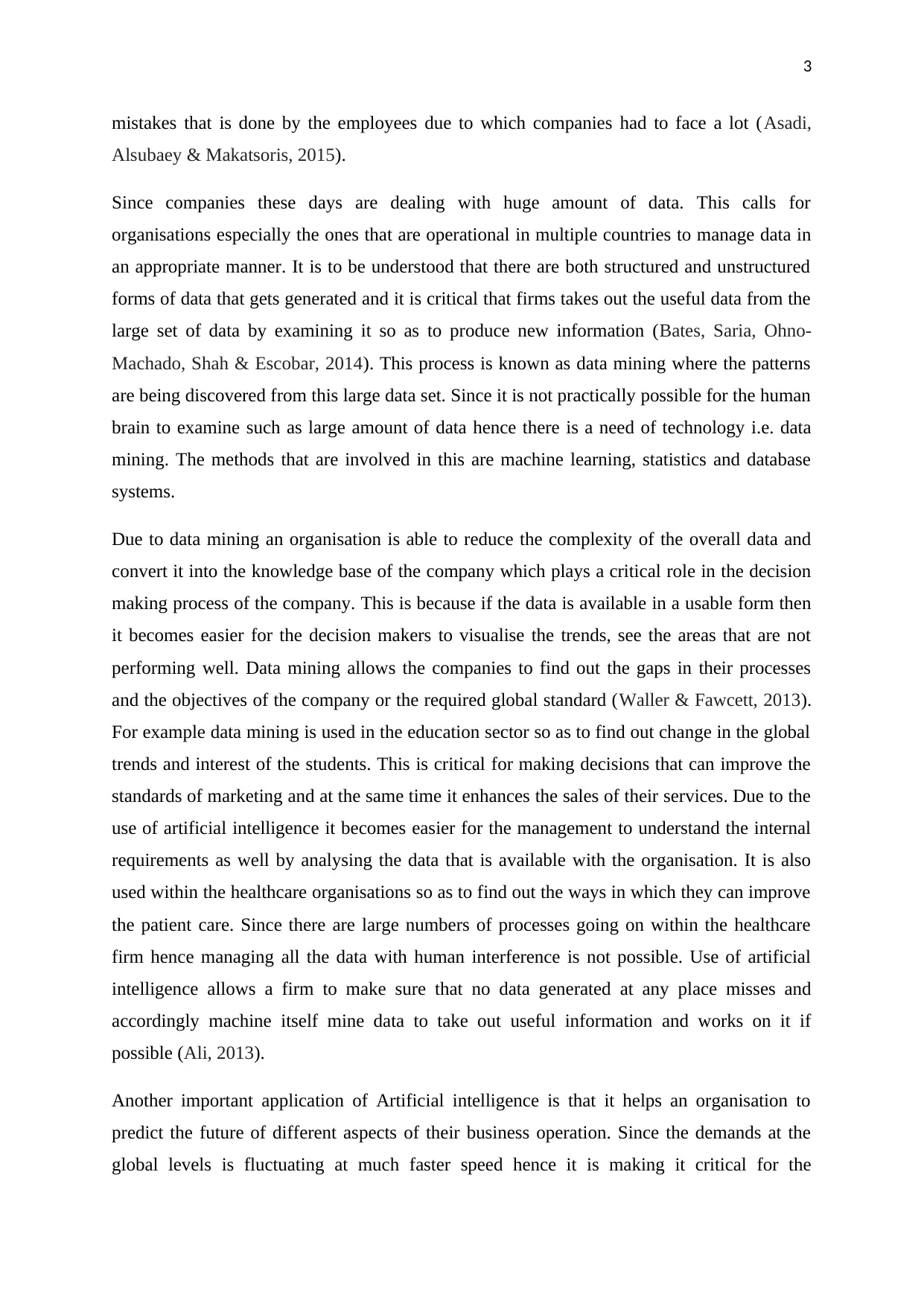
3
mistakes that is done by the employees due to which companies had to face a lot (Asadi,
Alsubaey & Makatsoris, 2015).
Since companies these days are dealing with huge amount of data. This calls for
organisations especially the ones that are operational in multiple countries to manage data in
an appropriate manner. It is to be understood that there are both structured and unstructured
forms of data that gets generated and it is critical that firms takes out the useful data from the
large set of data by examining it so as to produce new information (Bates, Saria, Ohno-
Machado, Shah & Escobar, 2014). This process is known as data mining where the patterns
are being discovered from this large data set. Since it is not practically possible for the human
brain to examine such as large amount of data hence there is a need of technology i.e. data
mining. The methods that are involved in this are machine learning, statistics and database
systems.
Due to data mining an organisation is able to reduce the complexity of the overall data and
convert it into the knowledge base of the company which plays a critical role in the decision
making process of the company. This is because if the data is available in a usable form then
it becomes easier for the decision makers to visualise the trends, see the areas that are not
performing well. Data mining allows the companies to find out the gaps in their processes
and the objectives of the company or the required global standard (Waller & Fawcett, 2013).
For example data mining is used in the education sector so as to find out change in the global
trends and interest of the students. This is critical for making decisions that can improve the
standards of marketing and at the same time it enhances the sales of their services. Due to the
use of artificial intelligence it becomes easier for the management to understand the internal
requirements as well by analysing the data that is available with the organisation. It is also
used within the healthcare organisations so as to find out the ways in which they can improve
the patient care. Since there are large numbers of processes going on within the healthcare
firm hence managing all the data with human interference is not possible. Use of artificial
intelligence allows a firm to make sure that no data generated at any place misses and
accordingly machine itself mine data to take out useful information and works on it if
possible (Ali, 2013).
Another important application of Artificial intelligence is that it helps an organisation to
predict the future of different aspects of their business operation. Since the demands at the
global levels is fluctuating at much faster speed hence it is making it critical for the
mistakes that is done by the employees due to which companies had to face a lot (Asadi,
Alsubaey & Makatsoris, 2015).
Since companies these days are dealing with huge amount of data. This calls for
organisations especially the ones that are operational in multiple countries to manage data in
an appropriate manner. It is to be understood that there are both structured and unstructured
forms of data that gets generated and it is critical that firms takes out the useful data from the
large set of data by examining it so as to produce new information (Bates, Saria, Ohno-
Machado, Shah & Escobar, 2014). This process is known as data mining where the patterns
are being discovered from this large data set. Since it is not practically possible for the human
brain to examine such as large amount of data hence there is a need of technology i.e. data
mining. The methods that are involved in this are machine learning, statistics and database
systems.
Due to data mining an organisation is able to reduce the complexity of the overall data and
convert it into the knowledge base of the company which plays a critical role in the decision
making process of the company. This is because if the data is available in a usable form then
it becomes easier for the decision makers to visualise the trends, see the areas that are not
performing well. Data mining allows the companies to find out the gaps in their processes
and the objectives of the company or the required global standard (Waller & Fawcett, 2013).
For example data mining is used in the education sector so as to find out change in the global
trends and interest of the students. This is critical for making decisions that can improve the
standards of marketing and at the same time it enhances the sales of their services. Due to the
use of artificial intelligence it becomes easier for the management to understand the internal
requirements as well by analysing the data that is available with the organisation. It is also
used within the healthcare organisations so as to find out the ways in which they can improve
the patient care. Since there are large numbers of processes going on within the healthcare
firm hence managing all the data with human interference is not possible. Use of artificial
intelligence allows a firm to make sure that no data generated at any place misses and
accordingly machine itself mine data to take out useful information and works on it if
possible (Ali, 2013).
Another important application of Artificial intelligence is that it helps an organisation to
predict the future of different aspects of their business operation. Since the demands at the
global levels is fluctuating at much faster speed hence it is making it critical for the
Paraphrase This Document
Need a fresh take? Get an instant paraphrase of this document with our AI Paraphraser
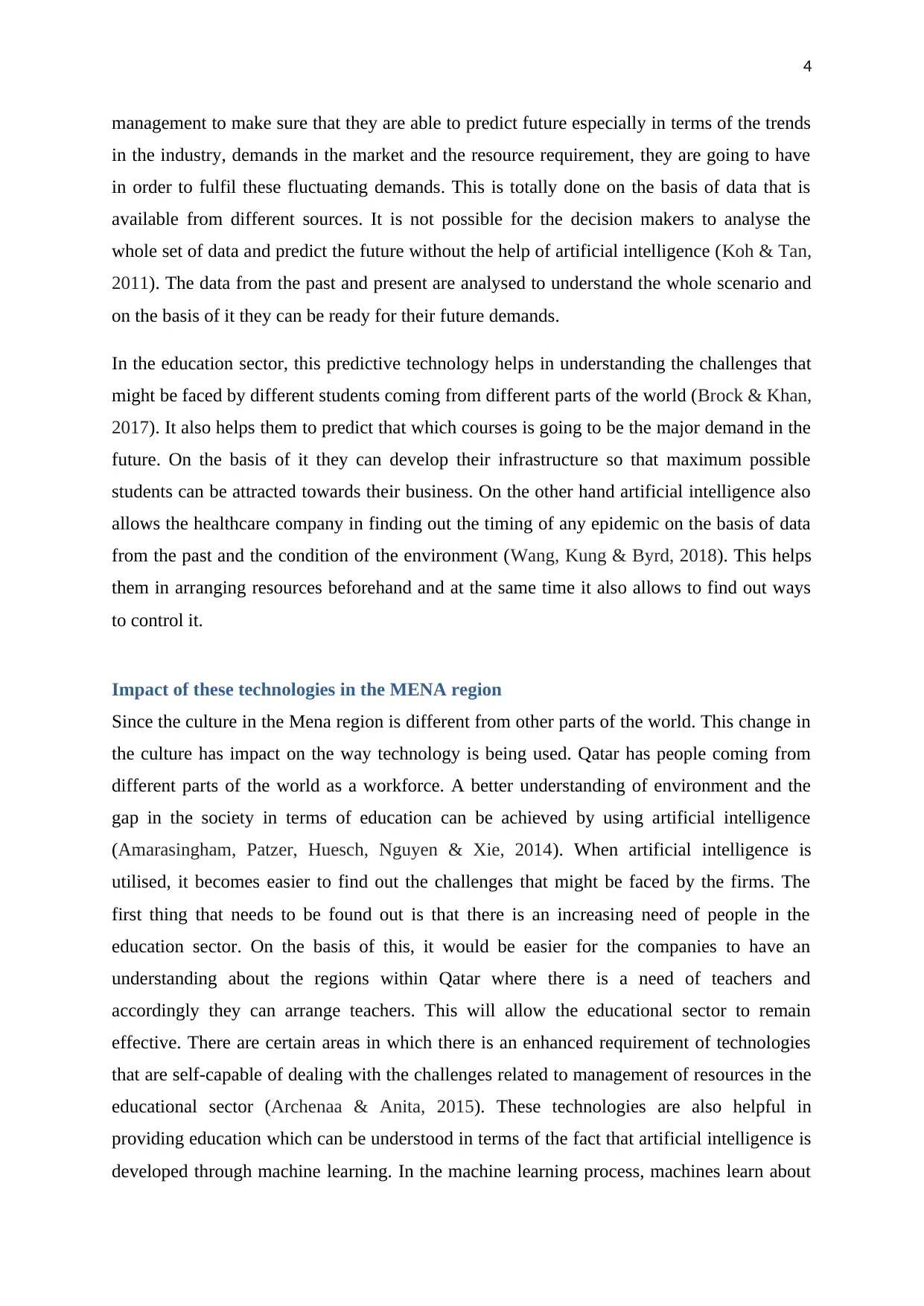
4
management to make sure that they are able to predict future especially in terms of the trends
in the industry, demands in the market and the resource requirement, they are going to have
in order to fulfil these fluctuating demands. This is totally done on the basis of data that is
available from different sources. It is not possible for the decision makers to analyse the
whole set of data and predict the future without the help of artificial intelligence (Koh & Tan,
2011). The data from the past and present are analysed to understand the whole scenario and
on the basis of it they can be ready for their future demands.
In the education sector, this predictive technology helps in understanding the challenges that
might be faced by different students coming from different parts of the world (Brock & Khan,
2017). It also helps them to predict that which courses is going to be the major demand in the
future. On the basis of it they can develop their infrastructure so that maximum possible
students can be attracted towards their business. On the other hand artificial intelligence also
allows the healthcare company in finding out the timing of any epidemic on the basis of data
from the past and the condition of the environment (Wang, Kung & Byrd, 2018). This helps
them in arranging resources beforehand and at the same time it also allows to find out ways
to control it.
Impact of these technologies in the MENA region
Since the culture in the Mena region is different from other parts of the world. This change in
the culture has impact on the way technology is being used. Qatar has people coming from
different parts of the world as a workforce. A better understanding of environment and the
gap in the society in terms of education can be achieved by using artificial intelligence
(Amarasingham, Patzer, Huesch, Nguyen & Xie, 2014). When artificial intelligence is
utilised, it becomes easier to find out the challenges that might be faced by the firms. The
first thing that needs to be found out is that there is an increasing need of people in the
education sector. On the basis of this, it would be easier for the companies to have an
understanding about the regions within Qatar where there is a need of teachers and
accordingly they can arrange teachers. This will allow the educational sector to remain
effective. There are certain areas in which there is an enhanced requirement of technologies
that are self-capable of dealing with the challenges related to management of resources in the
educational sector (Archenaa & Anita, 2015). These technologies are also helpful in
providing education which can be understood in terms of the fact that artificial intelligence is
developed through machine learning. In the machine learning process, machines learn about
management to make sure that they are able to predict future especially in terms of the trends
in the industry, demands in the market and the resource requirement, they are going to have
in order to fulfil these fluctuating demands. This is totally done on the basis of data that is
available from different sources. It is not possible for the decision makers to analyse the
whole set of data and predict the future without the help of artificial intelligence (Koh & Tan,
2011). The data from the past and present are analysed to understand the whole scenario and
on the basis of it they can be ready for their future demands.
In the education sector, this predictive technology helps in understanding the challenges that
might be faced by different students coming from different parts of the world (Brock & Khan,
2017). It also helps them to predict that which courses is going to be the major demand in the
future. On the basis of it they can develop their infrastructure so that maximum possible
students can be attracted towards their business. On the other hand artificial intelligence also
allows the healthcare company in finding out the timing of any epidemic on the basis of data
from the past and the condition of the environment (Wang, Kung & Byrd, 2018). This helps
them in arranging resources beforehand and at the same time it also allows to find out ways
to control it.
Impact of these technologies in the MENA region
Since the culture in the Mena region is different from other parts of the world. This change in
the culture has impact on the way technology is being used. Qatar has people coming from
different parts of the world as a workforce. A better understanding of environment and the
gap in the society in terms of education can be achieved by using artificial intelligence
(Amarasingham, Patzer, Huesch, Nguyen & Xie, 2014). When artificial intelligence is
utilised, it becomes easier to find out the challenges that might be faced by the firms. The
first thing that needs to be found out is that there is an increasing need of people in the
education sector. On the basis of this, it would be easier for the companies to have an
understanding about the regions within Qatar where there is a need of teachers and
accordingly they can arrange teachers. This will allow the educational sector to remain
effective. There are certain areas in which there is an enhanced requirement of technologies
that are self-capable of dealing with the challenges related to management of resources in the
educational sector (Archenaa & Anita, 2015). These technologies are also helpful in
providing education which can be understood in terms of the fact that artificial intelligence is
developed through machine learning. In the machine learning process, machines learn about
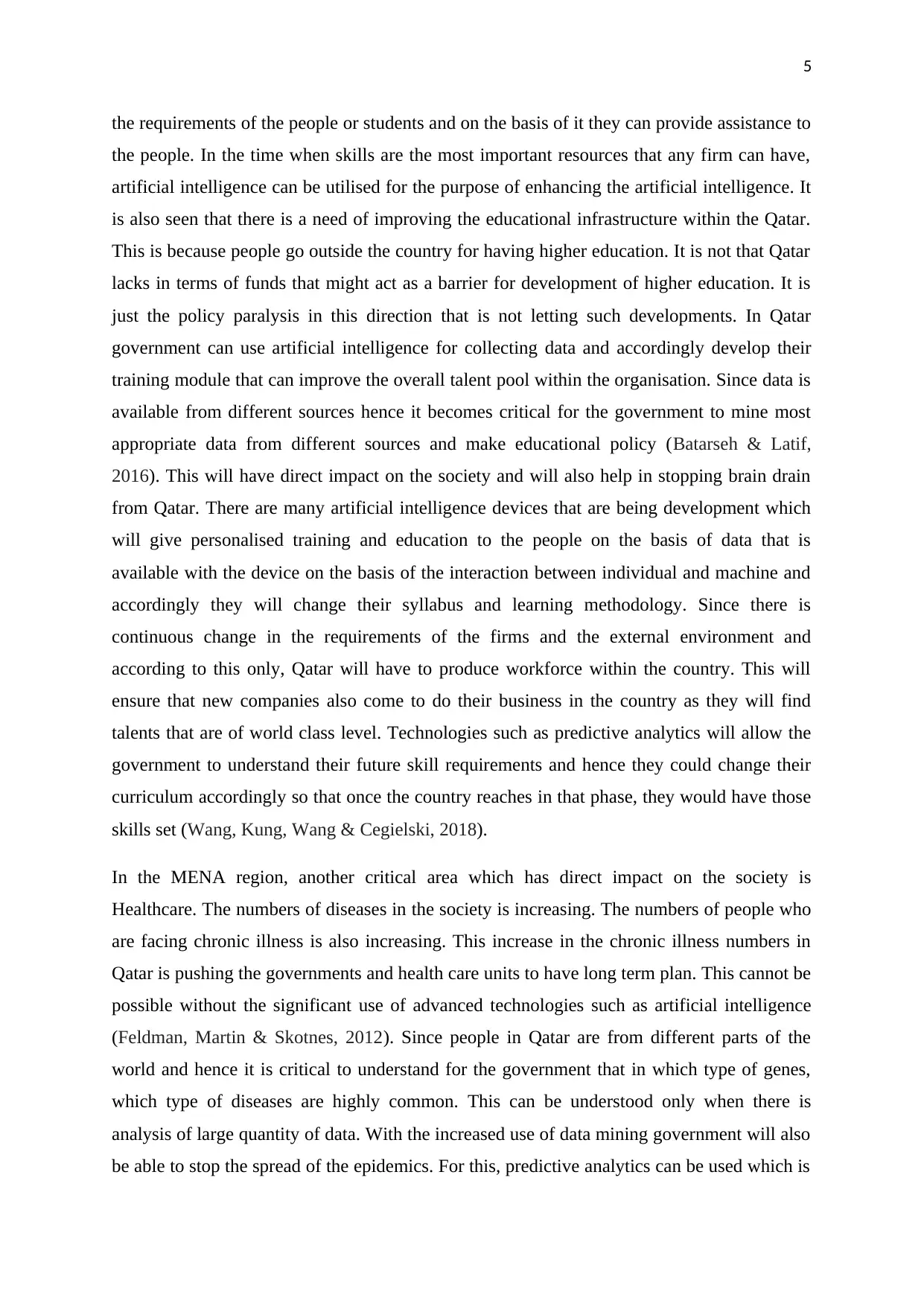
5
the requirements of the people or students and on the basis of it they can provide assistance to
the people. In the time when skills are the most important resources that any firm can have,
artificial intelligence can be utilised for the purpose of enhancing the artificial intelligence. It
is also seen that there is a need of improving the educational infrastructure within the Qatar.
This is because people go outside the country for having higher education. It is not that Qatar
lacks in terms of funds that might act as a barrier for development of higher education. It is
just the policy paralysis in this direction that is not letting such developments. In Qatar
government can use artificial intelligence for collecting data and accordingly develop their
training module that can improve the overall talent pool within the organisation. Since data is
available from different sources hence it becomes critical for the government to mine most
appropriate data from different sources and make educational policy (Batarseh & Latif,
2016). This will have direct impact on the society and will also help in stopping brain drain
from Qatar. There are many artificial intelligence devices that are being development which
will give personalised training and education to the people on the basis of data that is
available with the device on the basis of the interaction between individual and machine and
accordingly they will change their syllabus and learning methodology. Since there is
continuous change in the requirements of the firms and the external environment and
according to this only, Qatar will have to produce workforce within the country. This will
ensure that new companies also come to do their business in the country as they will find
talents that are of world class level. Technologies such as predictive analytics will allow the
government to understand their future skill requirements and hence they could change their
curriculum accordingly so that once the country reaches in that phase, they would have those
skills set (Wang, Kung, Wang & Cegielski, 2018).
In the MENA region, another critical area which has direct impact on the society is
Healthcare. The numbers of diseases in the society is increasing. The numbers of people who
are facing chronic illness is also increasing. This increase in the chronic illness numbers in
Qatar is pushing the governments and health care units to have long term plan. This cannot be
possible without the significant use of advanced technologies such as artificial intelligence
(Feldman, Martin & Skotnes, 2012). Since people in Qatar are from different parts of the
world and hence it is critical to understand for the government that in which type of genes,
which type of diseases are highly common. This can be understood only when there is
analysis of large quantity of data. With the increased use of data mining government will also
be able to stop the spread of the epidemics. For this, predictive analytics can be used which is
the requirements of the people or students and on the basis of it they can provide assistance to
the people. In the time when skills are the most important resources that any firm can have,
artificial intelligence can be utilised for the purpose of enhancing the artificial intelligence. It
is also seen that there is a need of improving the educational infrastructure within the Qatar.
This is because people go outside the country for having higher education. It is not that Qatar
lacks in terms of funds that might act as a barrier for development of higher education. It is
just the policy paralysis in this direction that is not letting such developments. In Qatar
government can use artificial intelligence for collecting data and accordingly develop their
training module that can improve the overall talent pool within the organisation. Since data is
available from different sources hence it becomes critical for the government to mine most
appropriate data from different sources and make educational policy (Batarseh & Latif,
2016). This will have direct impact on the society and will also help in stopping brain drain
from Qatar. There are many artificial intelligence devices that are being development which
will give personalised training and education to the people on the basis of data that is
available with the device on the basis of the interaction between individual and machine and
accordingly they will change their syllabus and learning methodology. Since there is
continuous change in the requirements of the firms and the external environment and
according to this only, Qatar will have to produce workforce within the country. This will
ensure that new companies also come to do their business in the country as they will find
talents that are of world class level. Technologies such as predictive analytics will allow the
government to understand their future skill requirements and hence they could change their
curriculum accordingly so that once the country reaches in that phase, they would have those
skills set (Wang, Kung, Wang & Cegielski, 2018).
In the MENA region, another critical area which has direct impact on the society is
Healthcare. The numbers of diseases in the society is increasing. The numbers of people who
are facing chronic illness is also increasing. This increase in the chronic illness numbers in
Qatar is pushing the governments and health care units to have long term plan. This cannot be
possible without the significant use of advanced technologies such as artificial intelligence
(Feldman, Martin & Skotnes, 2012). Since people in Qatar are from different parts of the
world and hence it is critical to understand for the government that in which type of genes,
which type of diseases are highly common. This can be understood only when there is
analysis of large quantity of data. With the increased use of data mining government will also
be able to stop the spread of the epidemics. For this, predictive analytics can be used which is
⊘ This is a preview!⊘
Do you want full access?
Subscribe today to unlock all pages.

Trusted by 1+ million students worldwide
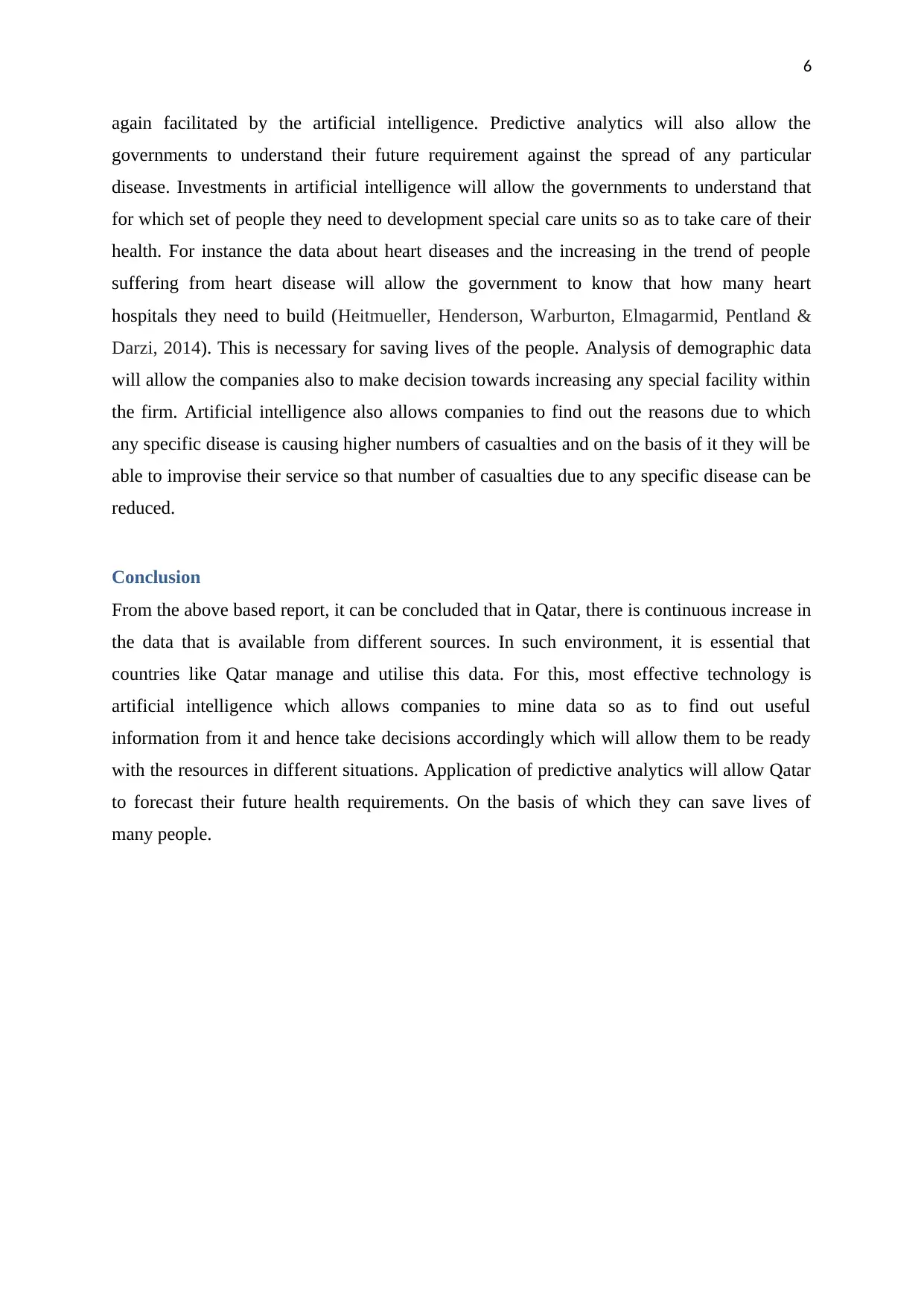
6
again facilitated by the artificial intelligence. Predictive analytics will also allow the
governments to understand their future requirement against the spread of any particular
disease. Investments in artificial intelligence will allow the governments to understand that
for which set of people they need to development special care units so as to take care of their
health. For instance the data about heart diseases and the increasing in the trend of people
suffering from heart disease will allow the government to know that how many heart
hospitals they need to build (Heitmueller, Henderson, Warburton, Elmagarmid, Pentland &
Darzi, 2014). This is necessary for saving lives of the people. Analysis of demographic data
will allow the companies also to make decision towards increasing any special facility within
the firm. Artificial intelligence also allows companies to find out the reasons due to which
any specific disease is causing higher numbers of casualties and on the basis of it they will be
able to improvise their service so that number of casualties due to any specific disease can be
reduced.
Conclusion
From the above based report, it can be concluded that in Qatar, there is continuous increase in
the data that is available from different sources. In such environment, it is essential that
countries like Qatar manage and utilise this data. For this, most effective technology is
artificial intelligence which allows companies to mine data so as to find out useful
information from it and hence take decisions accordingly which will allow them to be ready
with the resources in different situations. Application of predictive analytics will allow Qatar
to forecast their future health requirements. On the basis of which they can save lives of
many people.
again facilitated by the artificial intelligence. Predictive analytics will also allow the
governments to understand their future requirement against the spread of any particular
disease. Investments in artificial intelligence will allow the governments to understand that
for which set of people they need to development special care units so as to take care of their
health. For instance the data about heart diseases and the increasing in the trend of people
suffering from heart disease will allow the government to know that how many heart
hospitals they need to build (Heitmueller, Henderson, Warburton, Elmagarmid, Pentland &
Darzi, 2014). This is necessary for saving lives of the people. Analysis of demographic data
will allow the companies also to make decision towards increasing any special facility within
the firm. Artificial intelligence also allows companies to find out the reasons due to which
any specific disease is causing higher numbers of casualties and on the basis of it they will be
able to improvise their service so that number of casualties due to any specific disease can be
reduced.
Conclusion
From the above based report, it can be concluded that in Qatar, there is continuous increase in
the data that is available from different sources. In such environment, it is essential that
countries like Qatar manage and utilise this data. For this, most effective technology is
artificial intelligence which allows companies to mine data so as to find out useful
information from it and hence take decisions accordingly which will allow them to be ready
with the resources in different situations. Application of predictive analytics will allow Qatar
to forecast their future health requirements. On the basis of which they can save lives of
many people.
Paraphrase This Document
Need a fresh take? Get an instant paraphrase of this document with our AI Paraphraser
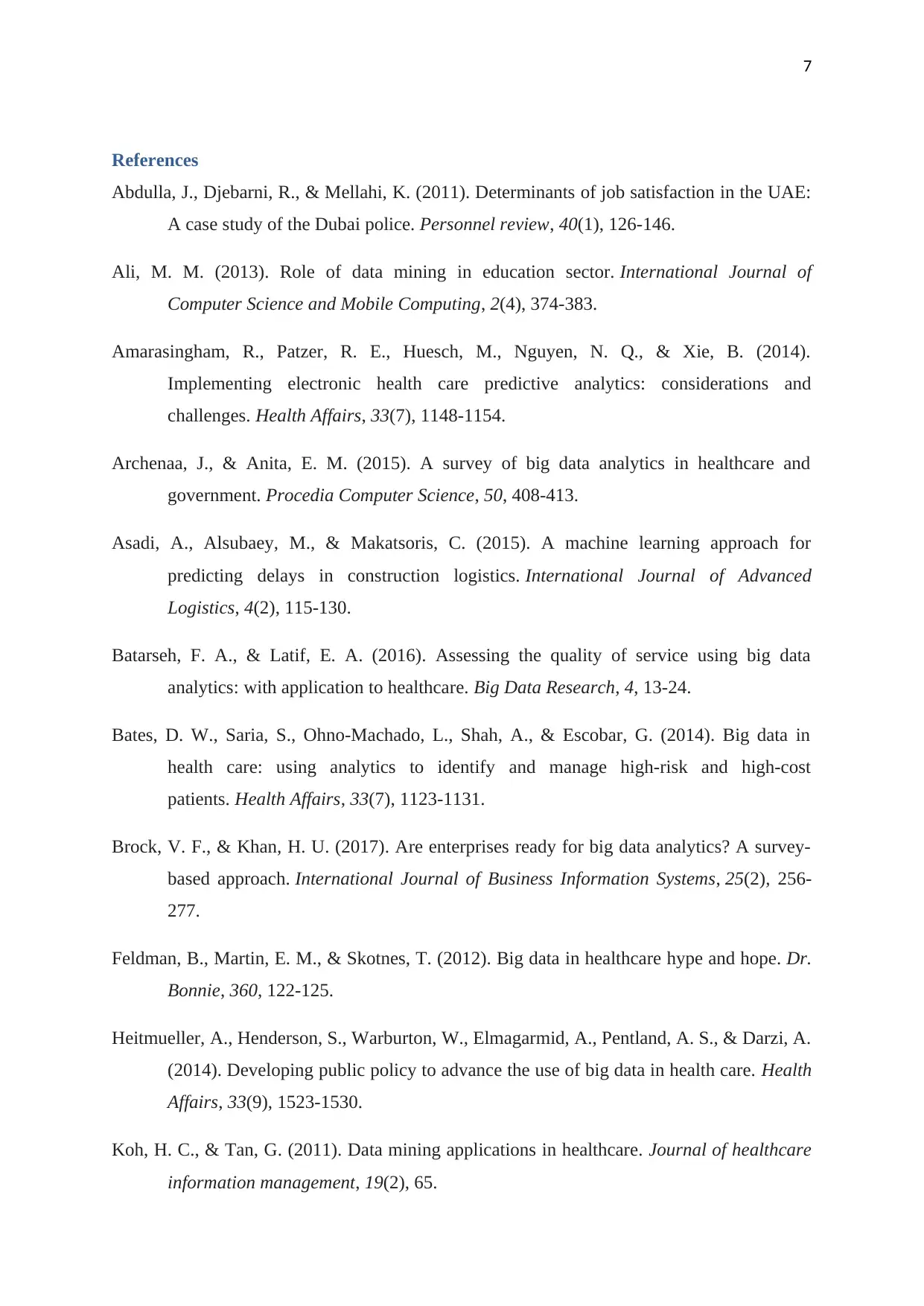
7
References
Abdulla, J., Djebarni, R., & Mellahi, K. (2011). Determinants of job satisfaction in the UAE:
A case study of the Dubai police. Personnel review, 40(1), 126-146.
Ali, M. M. (2013). Role of data mining in education sector. International Journal of
Computer Science and Mobile Computing, 2(4), 374-383.
Amarasingham, R., Patzer, R. E., Huesch, M., Nguyen, N. Q., & Xie, B. (2014).
Implementing electronic health care predictive analytics: considerations and
challenges. Health Affairs, 33(7), 1148-1154.
Archenaa, J., & Anita, E. M. (2015). A survey of big data analytics in healthcare and
government. Procedia Computer Science, 50, 408-413.
Asadi, A., Alsubaey, M., & Makatsoris, C. (2015). A machine learning approach for
predicting delays in construction logistics. International Journal of Advanced
Logistics, 4(2), 115-130.
Batarseh, F. A., & Latif, E. A. (2016). Assessing the quality of service using big data
analytics: with application to healthcare. Big Data Research, 4, 13-24.
Bates, D. W., Saria, S., Ohno-Machado, L., Shah, A., & Escobar, G. (2014). Big data in
health care: using analytics to identify and manage high-risk and high-cost
patients. Health Affairs, 33(7), 1123-1131.
Brock, V. F., & Khan, H. U. (2017). Are enterprises ready for big data analytics? A survey-
based approach. International Journal of Business Information Systems, 25(2), 256-
277.
Feldman, B., Martin, E. M., & Skotnes, T. (2012). Big data in healthcare hype and hope. Dr.
Bonnie, 360, 122-125.
Heitmueller, A., Henderson, S., Warburton, W., Elmagarmid, A., Pentland, A. S., & Darzi, A.
(2014). Developing public policy to advance the use of big data in health care. Health
Affairs, 33(9), 1523-1530.
Koh, H. C., & Tan, G. (2011). Data mining applications in healthcare. Journal of healthcare
information management, 19(2), 65.
References
Abdulla, J., Djebarni, R., & Mellahi, K. (2011). Determinants of job satisfaction in the UAE:
A case study of the Dubai police. Personnel review, 40(1), 126-146.
Ali, M. M. (2013). Role of data mining in education sector. International Journal of
Computer Science and Mobile Computing, 2(4), 374-383.
Amarasingham, R., Patzer, R. E., Huesch, M., Nguyen, N. Q., & Xie, B. (2014).
Implementing electronic health care predictive analytics: considerations and
challenges. Health Affairs, 33(7), 1148-1154.
Archenaa, J., & Anita, E. M. (2015). A survey of big data analytics in healthcare and
government. Procedia Computer Science, 50, 408-413.
Asadi, A., Alsubaey, M., & Makatsoris, C. (2015). A machine learning approach for
predicting delays in construction logistics. International Journal of Advanced
Logistics, 4(2), 115-130.
Batarseh, F. A., & Latif, E. A. (2016). Assessing the quality of service using big data
analytics: with application to healthcare. Big Data Research, 4, 13-24.
Bates, D. W., Saria, S., Ohno-Machado, L., Shah, A., & Escobar, G. (2014). Big data in
health care: using analytics to identify and manage high-risk and high-cost
patients. Health Affairs, 33(7), 1123-1131.
Brock, V. F., & Khan, H. U. (2017). Are enterprises ready for big data analytics? A survey-
based approach. International Journal of Business Information Systems, 25(2), 256-
277.
Feldman, B., Martin, E. M., & Skotnes, T. (2012). Big data in healthcare hype and hope. Dr.
Bonnie, 360, 122-125.
Heitmueller, A., Henderson, S., Warburton, W., Elmagarmid, A., Pentland, A. S., & Darzi, A.
(2014). Developing public policy to advance the use of big data in health care. Health
Affairs, 33(9), 1523-1530.
Koh, H. C., & Tan, G. (2011). Data mining applications in healthcare. Journal of healthcare
information management, 19(2), 65.
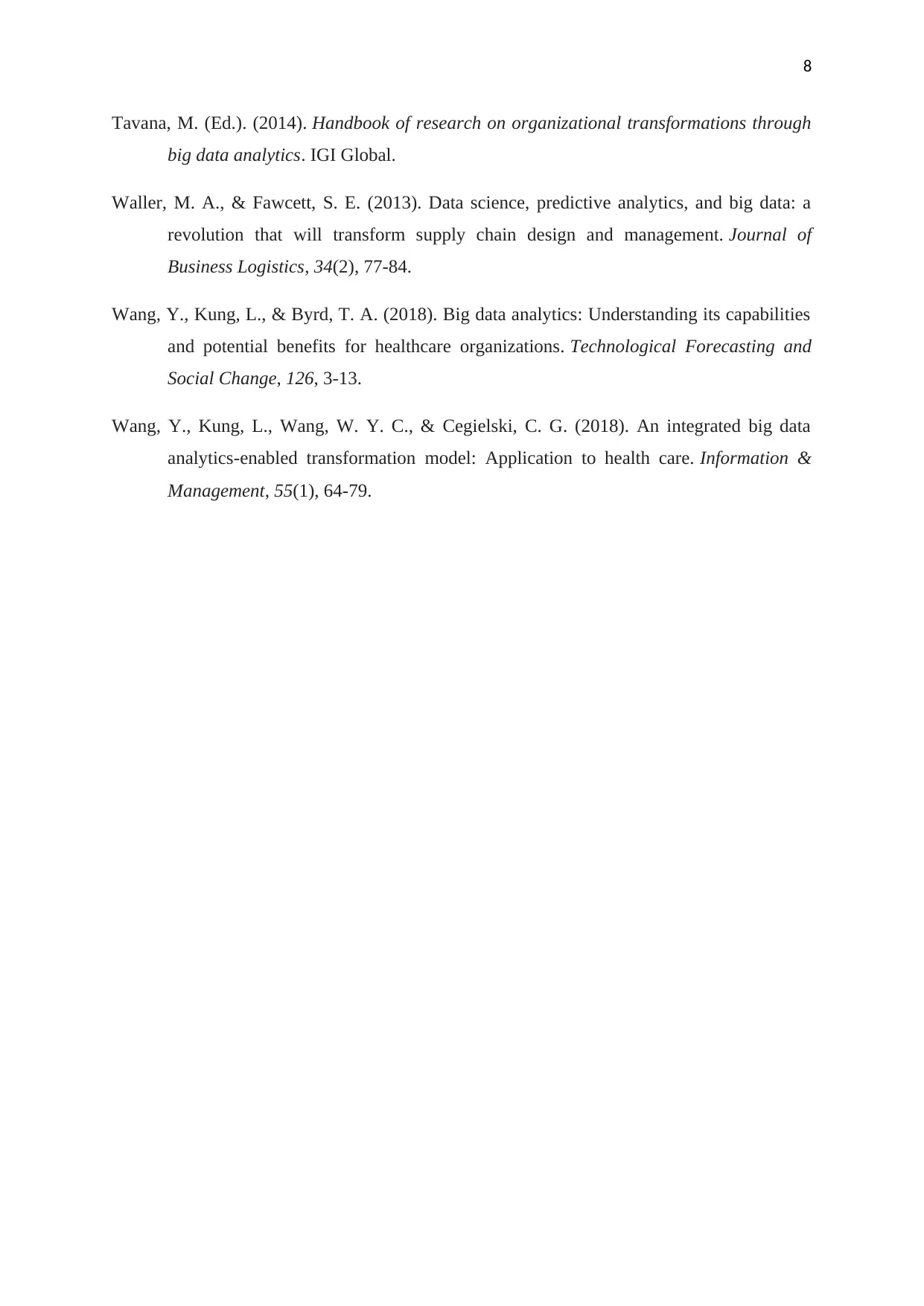
8
Tavana, M. (Ed.). (2014). Handbook of research on organizational transformations through
big data analytics. IGI Global.
Waller, M. A., & Fawcett, S. E. (2013). Data science, predictive analytics, and big data: a
revolution that will transform supply chain design and management. Journal of
Business Logistics, 34(2), 77-84.
Wang, Y., Kung, L., & Byrd, T. A. (2018). Big data analytics: Understanding its capabilities
and potential benefits for healthcare organizations. Technological Forecasting and
Social Change, 126, 3-13.
Wang, Y., Kung, L., Wang, W. Y. C., & Cegielski, C. G. (2018). An integrated big data
analytics-enabled transformation model: Application to health care. Information &
Management, 55(1), 64-79.
Tavana, M. (Ed.). (2014). Handbook of research on organizational transformations through
big data analytics. IGI Global.
Waller, M. A., & Fawcett, S. E. (2013). Data science, predictive analytics, and big data: a
revolution that will transform supply chain design and management. Journal of
Business Logistics, 34(2), 77-84.
Wang, Y., Kung, L., & Byrd, T. A. (2018). Big data analytics: Understanding its capabilities
and potential benefits for healthcare organizations. Technological Forecasting and
Social Change, 126, 3-13.
Wang, Y., Kung, L., Wang, W. Y. C., & Cegielski, C. G. (2018). An integrated big data
analytics-enabled transformation model: Application to health care. Information &
Management, 55(1), 64-79.
⊘ This is a preview!⊘
Do you want full access?
Subscribe today to unlock all pages.

Trusted by 1+ million students worldwide
1 out of 9
Related Documents
Your All-in-One AI-Powered Toolkit for Academic Success.
+13062052269
info@desklib.com
Available 24*7 on WhatsApp / Email
![[object Object]](/_next/static/media/star-bottom.7253800d.svg)
Unlock your academic potential
Copyright © 2020–2025 A2Z Services. All Rights Reserved. Developed and managed by ZUCOL.





